
views
MLA
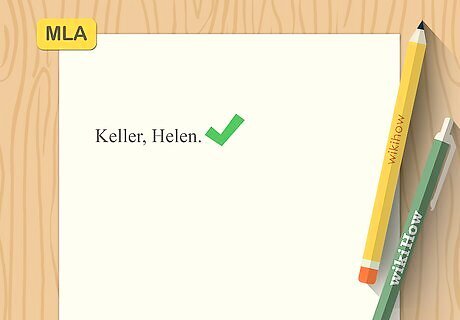
Always start with the name of the person who wrote the letter. List the writer's name with their last name first, then a comma. After the comma, type the person's first name and their middle initial, if available. Close this section of your citation with a period. Example: Keller, Helen.

Add the title or subject line of the letter in quotation marks. If the letter has a title or subject line, provide that after the name of the person who wrote the letter. Use title-case, capitalizing most words, including nouns, pronouns, adjectives, verbs, and adverbs. Place a period inside the quotation marks at the end of the title. Example: Smith, John. "Inspirational Quotes for Students."
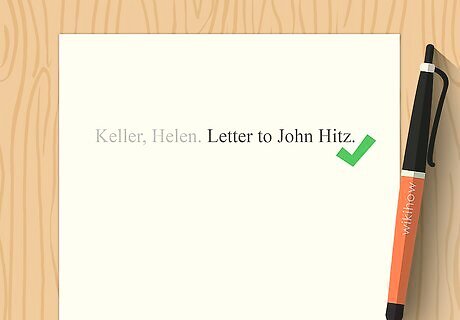
Use a generic description if there is no title or subject line. Some letters, particularly historic correspondence, won't have a title or subject line. In this case, identify the source as a letter and state who it was written to. End your description with a period. Example: Keller, Helen. Letter to John Hitz.
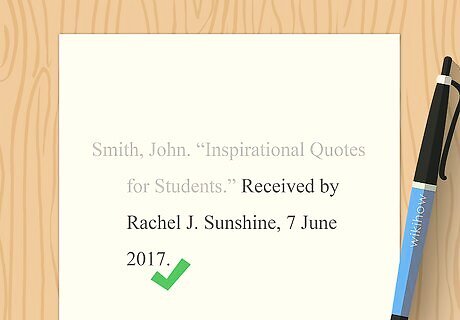
Indicate who received the letter and the date it was received. When citing unpublished letters or personal correspondence, include the name of the person who received the letter. List their first name first, followed by their middle initial (if any) and their last name. Place a comma after the name, then include the date they received the letter in day-month-year format. If you don't know the date the letter was received, use the date on the letter itself. Example: Smith, John. "Inspirational Quotes for Students." Received by Sally J. Sunshine, 7 September 2017. If the name of the recipient was already included in a generic description of the letter, do not repeat it. Instead, simply include the date after the description. For example: Keller, Helen. Letter to John Hitz. 29 August 1893.

Include collection or location information, if appropriate. Letters by famous writers or people of historical significance are often preserved in library collections for use by researchers. Name the collection, then place a comma. After the comma, provide the name and location of the institution that houses the collection. End your citation with the format of the letter. Example: Keller, Helen. Letter to John Hitz. 29 August 1893. Alexander Graham Bell Family Papers, Library of Congress, Washington, D.C. Manuscript.

Include a description and date for in-text parenthetical citations. When citing the letter in the text of your paper or report, the information you include in your parenthetical citation will depend to some extent on which details you've included in the text itself. If you include the name of the writer and the date of the letter, you wouldn't need to repeat the same information in your parenthetical citation. For example: "Helen Keller described her trip to Chicago in an 1893 letter to John Hitz (Letter)." If Helen Keller wrote several letters to John Hitz that you are using as references, use specific dates to distinguish the letters in your parenthetical citations. For example: Helen Keller described her trip to Chicago in an 1893 letter to John Hitz (Letter [29 August])." A full parenthetical citation would include the name of the addressee and the date of the letter. For example: "Helen Keller traveled to Chicago to visit the World's Columbian Exposition of 1893 (Letter to John Hitz [29 August])."
APA

Start your full citation with the author's last name. In the case of a letter, the author is the person who wrote the letter. Type their last name first, followed by a comma. Then type their first initial. Include their middle initial if it is available. Example: Keller, H.
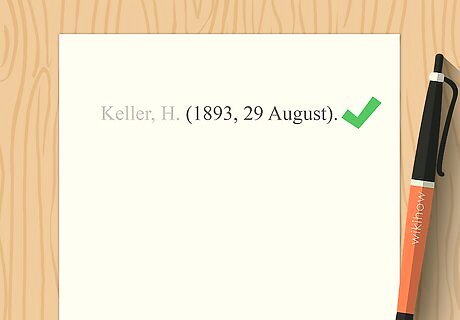
Include the date of the letter in parentheses. If the letter has a date on it, place that information after the writer's name in your citation. Start with the year. If the letter includes a month and a day, put a comma after the year, then type the number of the day and the name of the month. Place a period after the closing parentheses. Example: Keller, H. (1893, 29 August). If you have multiple letters from the same author in the same year, assign a letter to each so you can distinguish them when citing them parenthetically in the body of your paper. For example: Keller, H. (1893a, 29 August).
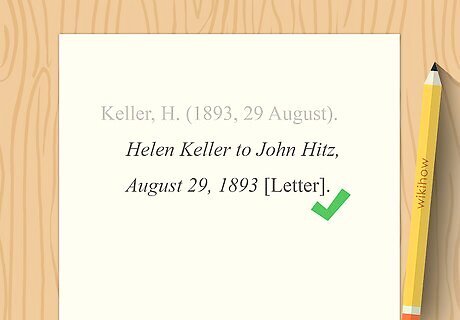
Provide a title for the document with description. The title of a letter typically includes the author and recipient of the letter, along with the date. If the letter is a standalone document, format the title in italics. Use sentence-case, capitalizing only the initial word and any proper nouns. If it is part of a larger work or collection, do not italicize the title. Place the word "Letter" in square brackets after the title to indicate the format of the document. Follow the closing bracket with a period. Example: Keller, H. (1893, 29 August). Helen Keller to John Hitz, August 29, 1893 [Letter].

Close with a URL if you accessed the letter online. Many archival sources, such as letters, have been scanned so they can be made available to more researchers online. For online letters, type "Retrieved from" and then provide a full URL for the letter. Example: Keller, H. (1893, 29 August). Helen Keller to John Hitz, August 29, 1893 [Letter]. Retrieved from http://www.loc.gov/item/magbellbib004020

Close with location information if the letter is archived. Some old letters can be found in archives and special collections of libraries or museums. If you examined the print letter rather than an image online, name the library or museum and the specific location of that letter in the collection. Example: Keller, H. (1893, 29 August). Helen Keller to John Hitz, August 29, 1893 [Letter]. Alexander Graham Bell Family Papers, Library of Congress, Washington, D.C.

Use in-text citations only for personal communications. Since a letter you received is not a source that someone else can recover, it doesn't need a separate entry in your list of references. Instead, simply note in the parenthetical citation within your text that it is personal communication. Your parenthetical citation typically will list the name of the writer of the letter, the phrase "personal communication," and the date of the letter. For example: (J. Smith, personal communication, September 7, 2017)

Use author-year parenthetical citations in the body of your paper. APA style requires parenthetical citations that point your reader back to the full citation in your reference list. Include the last name of the person who wrote the letter, then the year the letter was written. Add lowercase letters after the year to distinguish several letters written in the same year. Example: (Keller, 1893a)
Chicago

Start your bibliographic citation with the name of the author. With a letter, the author is the person who wrote the letter. Put their last name first, then a comma followed by their first name and middle initial (if it's available). Place a period at the end of the name. Example: Keller, Helen.

Provide a title for the letter that lists the writer and recipient. After the author's name, type the name of the author again (in first name-last name format). Follow it with the word "to," then write the name of the recipient of the letter. Place a comma after this "title." Example: Keller, Helen. Helen Keller to John Hitz,

Include the location where the letter was written, if available. Many letters have the name of a city listed at the top. If you have this information, include it after the "title" of the letter. Fill in the state (for US addresses) or the country (for other places) if necessary. If the state or country is unclear, leave it out of your citation. Place a comma after the location information. Example: Keller, Helen. Helen Keller to John Hitz, Chicago, IL,

List the full date when the letter was written. Using month-day-year format, include as much information as you have from the letter itself about the date when it was written. Place a period at the end of the date. If the letter is a standalone document, this is all the information you need in your bibliographic citation. Example: Keller, Helen. Helen Keller to John Hitz, Chicago, IL, August 29, 1893.
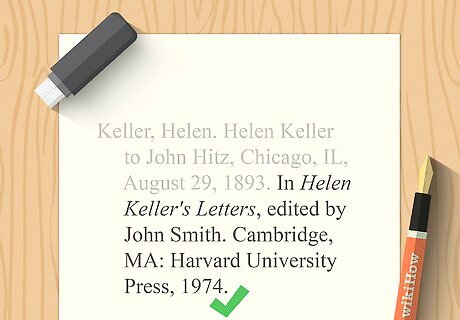
Close with publication information for letters in archival collections. Some letters are published in a print collection, or included in the archives or special collections of a library or museum. Many archival letters are also scanned and available online. If you accessed the letter through any of these means, provide information about where you found the letter so your readers may access it as well. Print collection example: Keller, Helen. Helen Keller to John Hitz, Chicago, IL, August 29, 1893. In Helen Keller's Letters, edited by John Smith. Cambridge, MA: Harvard University Press, 1974. Archives example: Keller, Helen. Helen Keller to John Hitz, Chicago, IL, August 29, 1893. Letter. Series MSS51268. Library of Congress. The Alexander Graham Bell Family Papers, 1862-1939. Online example: Keller, Helen. Helen Keller to John Hitz, Chicago, IL, August 29, 1893. http://www.loc.gov/item/magbellbib004020.

Start your footnotes with the "title" of the letter. In your footnotes in the body of your paper, omit the first mention of the author's name. Instead, go straight to the title of the letter. Place a comma after the title and add the date. For standalone print letters, this is all the information you need for the footnote. Example: Helen Killer to John Hitz, August 29, 1893.
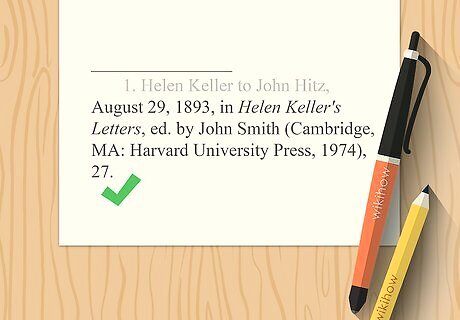
Include publication information for letters in archival collections. If the letter is part of a print collection, online database, or other online collection, include information about the letter's location in your footnote as well. If the letter was published in a print collection, include the title and publication information of the book. End your footnote with the page number where the specific letter can be found. For example: Helen Keller to John Hitz, August 29, 1893, in Helen Keller's Letters, ed. by John Smith (Cambridge, MA: Harvard University Press, 1974), 27. For databases or online collections, provide the name of the database or URL. For example: Helen Keller to John Hitz, August 29, 1893, http://www.loc.gov/item/magbellbib004020.




















Comments
0 comment